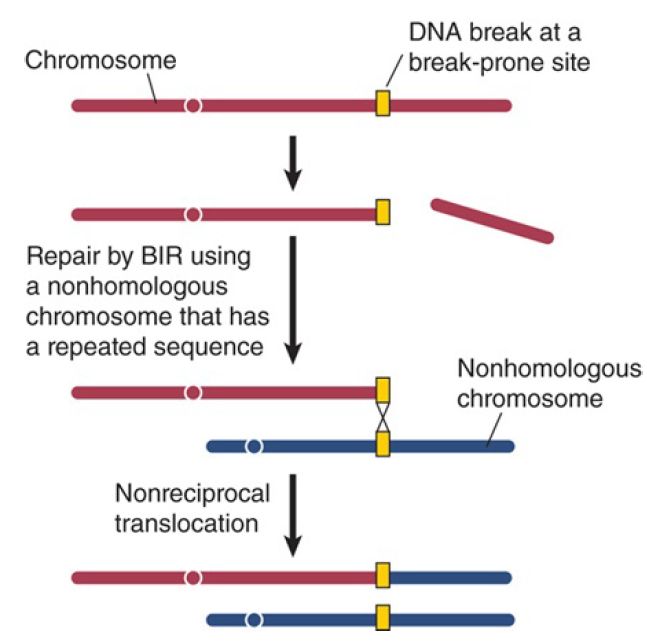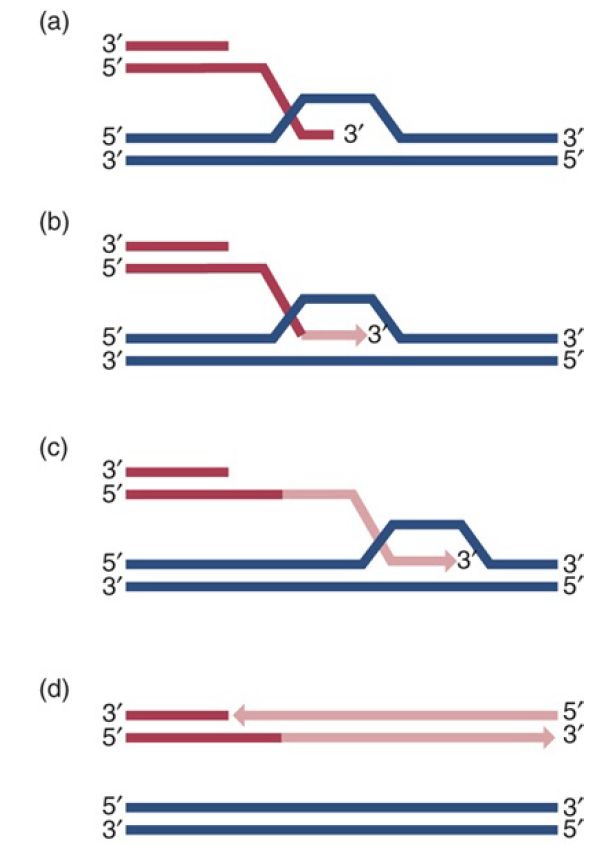
Break-Induced Replication Can Repair Double-Strand Breaks
 المؤلف:
JOCELYN E. KREBS, ELLIOTT S. GOLDSTEIN and STEPHEN T. KILPATRICK
المؤلف:
JOCELYN E. KREBS, ELLIOTT S. GOLDSTEIN and STEPHEN T. KILPATRICK
 المصدر:
LEWIN’S GENES XII
المصدر:
LEWIN’S GENES XII
 الجزء والصفحة:
الجزء والصفحة:
 15-4-2021
15-4-2021
 2767
2767
Break-Induced Replication Can Repair Double-Strand Breaks
KEY CONCEPTS
- Break-induced replication (BIR) is initiated by a oneended double-strand break.
- BIR at repeated sequences can result in translocations.
We saw in the previous section that DSBs between direct repeats can induce the single-strand annealing mechanism. There are other types of repeat sequences at which DSBs induce a repair
mechanism known as break-induced replication (BIR). During DNA replication, certain sequences termed fragile sites are particularly susceptible to DSB formation. They often contain repeat sequences related to those found in transposable elements (discussed in the chapter titled Transposable Elements and Retroviruses) and are located throughout the genome. Fragile sites are prone to breakage during DNA replication, creating a DSB at the site of replication. Break-induced replication can initiate repair from these DSBs by using the homologous sequence from a repeat on a nonhomologous chromosome, creating a nonreciprocal translocation, as shown in FIGURE 1.

FIGURE 1. Break-induced replication can result in nonreciprocal translocations. A DNA break on the red chromosome results in loss of the chromosome end and a break with only one end. The end is repaired by recombination, using a homologous sequence found on a different chromosome, here the blue chromosome. Because there is only one end at the broken chromosome, repair occurs by copying the blue chromosome sequence to the end. This results in a translocation of some of the blue chromosome sequence to the red chromosome.
The mechanism of BIR involves resection of the double-strand break end to leave a 3′–OH single-strand overhang, which can then undergo strand invasion at a homologous sequence, as shown in FIGURE 2. The invading strand causes the formation of a Dloop that can be thought of as a replication bubble. The invading strand is then extended using the donor DNA as template for replication. When the invading strand is displaced, it can then act as a single-stranded template on which synthesis can be primed to create double-stranded DNA. The template strand is used until replication reaches the end of the chromosome; as a result, gene conversions from BIR events can be hundreds of kilobases long.
Additionally, chromosome translocations can occur from this process if the homology used during strand invasion is a result of repeat sequences present at various sites in the genome. Template switching that occurs during BIR can result in some of the complex chromosomal rearrangements that are seen in tumor cells.

FIGURE 2. Possible mechanisms of break-induced replication. Strand invasion into homologous sequences by a single-strand tail with a 3′–OH end forms a D-loop. In (a), synthesis results in a single-strand region that is later converted into duplex DNA. In (b), a single replication fork is formed that moves in one direction to the end of the template sequence. Resolution of the Holliday junction results in newly synthesized DNA on both molecules. In (c), the Holliday junction branch migrates to result in newly synthesized DNA only on the broken strand, as in (a). (d) Shows the final products after resolution.
Data from M. J. McEachern and J. E. Haber, Annu. Rev. Biochem. 75 (2006): 111–135.
 الاكثر قراءة في مواضيع عامة في الاحياء الجزيئي
الاكثر قراءة في مواضيع عامة في الاحياء الجزيئي
 اخر الاخبار
اخر الاخبار
اخبار العتبة العباسية المقدسة


